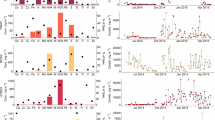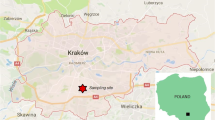Abstract
Improving knowledge on the apportionment of airborne particulate matter will be useful to handle and fulfill the legislation regarding this pollutant. The main aim of this work was to assess the influence of markers in the source apportionment of airborne PM10, in particular, whether the use of particle polycyclic aromatic hydrocarbon (PAH) and ions provided similar results to the ones obtained using not only the mentioned markers but also gas phase PAH and trace elements. In order to reach this aim, two receptor models: UNMIX and positive matrix factorization were applied to two sets of data in Zaragoza city from airborne PM10, a previously reported campaign (2003–2004) (Callén et al. Chemosphere 76:1120-1129, 2009), where PAH associated to the gas and particle phases, ions and trace elements were used as markers and a long sampling campaign (2001–2009), where only PAH in the particle phase and ions were analyzed. For both campaigns, positive matrix factorization was able to explain a higher number of sources than the UNMIX model. Independently of the sampling campaign and the receptor model used, soil resuspension was the main PM10 source, especially in the warm period (21st March–21st September), where most of the PM10 exceedances were produced. Despite some of the markers of anthropogenic sources were different for both campaigns, common sources associated to different combustion sources (coal, light-oil, heavier-oil, biomass, and traffic) were found and PAH in particle phase and ions seemed to be good markers for the airborne PM10 apportionment.




Similar content being viewed by others
References
Artiñano B, Salvador P, Pujadas M (2009) Study of atmospheric pollution by particulated matter in Madrid (I): source apportionment. Física de la Tierra 21:41–49
Bari MA, Baumbach G, Kuch B, Scheffknecht G (2009) Wood smoke as a source of particle-phase organic compounds in residential areas. Atmos Environ 43:4722–4732
Bogo H, Otero M, Castro P, Ozafrán MJ, Kreiner A, Calvo EJ, Martín Negri R (2003) Study of atmospheric particulate matter in Buenos Aires city. Atmos Environ 37:1135–1147
Bourotte C, Forti MC, Taniguchi S, Bicego MC, Lotufo PA (2005) A wintertime study of PAHs in fine and coarse aerosols in Sao Paulo city, Brazil. Atmos Environ 39:3799–3811
Callén MS, de la Cruz MT, López JM, Murillo R, Navarro MV, Mastral AM (2008a) Long-range atmospheric transport and local pollution sources on PAH concentrations in a South European urban area. Fulfilling of the European Directive. Water Air Soil Poll 190:1–4
Callén MS, de la Cruz MT, López JM, Murillo R, Navarro MV, Mastral AM (2008b) Some inferences on the mechanism of atmospheric gas/particle partitioning of polycyclic aromatic hydrocarbons (PAH) at Zaragoza (Spain). Chemosphere 73:1357–1365
Callén MS, de la Cruz MT, López JM, Navarro MV, Mastral AM (2009) Comparison of receptor models for source apportionment of the PM10 in Zaragoza (Spain). Chemosphere 76:1120–1129
Callén MS, López JM, Mastral AM (2012) Apportionment of the airborne PM10 in Spain. Episodes of potential negative impact for human health. J Environ Monit 14:1211–1220
Directive 2008/50/EC of the European parliament and of the council of 21 May 2008 on ambient air quality and cleaner air for Europe
Duce RA, Arimoto BJ, Ray BJ, Unni CK, Harder PJ (1983) Atmospheric trace elements at Enewetak Atoll: 1, Concentrations, sources and temporal variability. J Geophys Res 88:5321–5342
Dutton SJ, Vedal S, Piedrahita R, Milford JB, Miller SL, Hannigan MP (2010) Source apportionment using positive matrix factorization on daily measurements of inorganic and organic speciated PM2.5. Atmos Environ 44:2731–2741
EN 12341 (1998) Air quality—determination of the PM 10 fraction of suspended particulate matter—Reference method and field test procedure to demonstrate reference equivalence of measurement methods
European Union (2001) Ambient air pollution by polycyclic aromatic hydrocarbons (PAH). Position Paper. Office for Official Publications of the European Communities, Luxembourg (ISBN 92-894-2057-X)
Henry RC (2000) UNMIX Version 2 Manual, pp. 18–19
Henry RC (2003) Multivariate receptor modeling by N-dimensional edge detection. Chemom Intell Lab Syst 65:179–189
Hu SH, McDonald R, Martuzevicius D, Biswas P, Grinshpun SA, Kelley A, Reponen T, Lockey J, LeMasters G (2006) UNMIX modeling of ambient PM2.5 near an interstate highway in Cincinnati, OH, USA. Atmos Environ 40:S378–S395
Jeong CH, Evans GJ, Dann T, Graham M, Herod D, Zlotorzynska ED, Mathieu D, Ding L, Wang D (2008) Influence of biomass burning on wintertime fine particulate matter: source contribution at a valley site in rural British Columbia. Atmos Environ 42:3684–3699
Khalili NR, Scheff PA, Holsen TM (1995) PAH source fingerprints for coke ovens, diesel and gasoline engines, highway tunnels and wood combustion emissions. Atmos Environ 29(4):533–542
Kim E, Hopke PK (2004) Comparison between conditional probability function and nonparametric regression for fine particle source directions. Atmos Environ 38:4667–4673
Kim E, Hopke PK, Edgeron ES (2004) Improving source identification of Atlanta aerosol using temperature resolve carbon fractions in positive matrix factorization. Atmos Environ 38:3349–3362
Lee JH, Gigliotti CL, Offenberg JH, Eisenreich SJ, Turpin BJ (2004) Sources of polycyclic aromatic hydrocarbons to the Hudson River airshed. Atmos Environ 38:5971–5981
López JM, Callén MS, Murillo R, Garcia T, Navarro MV, de la Cruz MT, Mastral AM (2005) Levels of selected metals in ambient air PM10 in an urban site of Zaragoza (Spain). Environ Res 99:58–67
Ma W-L, Li Y-F, Qi H, Sun D-Z, Liu L-Y, Wang D-G (2010) Seasonal variation of sources of polycyclic aromatic hydrocarbons (PAHs) to a northeastern urban city, China. Chemosphere 79:441–447
Mooibroek D, Schaap M, Weijers EP, Hoogerbrugge R (2011) Source apportionment and spatial variability of PM2.5 using measurements at five sites in the Netherlands. Atmos Environ 45(25):4180–4191
Moon KJ, Han JS, Ghim YS, Kim YJ (2008) Source apportionment of fine carbonaceous particles by positive matrix factorization at Gosan background site in East Asia. Environ Internat 34:654–664
Oanh NTK, Pongkiatkul P, Upadhyay N, Hopke PP (2009) Designing ambient particulate matter monitoring program for source apportionment study by receptor modelling. Atmos Environ 43:3334–3344
Okuda T, Okamoto K, Tanaka S, Shen Z, Han Y, Huo Z (2010) Measurement and source identification of polycyclic aromatic hydrocarbons (PAHs) in the aerosol in **´an, China by using automated column chromatography and applying positive matrix factorization (PMF). Sci Total Environ 408:1909–1914
Paatero P (1997) Least squares formulation of robust non-negative factor analysis. Chemom Intell Lab Syst 37:23–35
Paatero P, Tapper U (1994) Positive Matrix Factorization: a non-negative factor model with optimal utilization of error estimates of data values. Environmetrics 5:111–126
Pant P, Harrison RM (2012) Critical review of receptor modelling for particulate matter: a case study of India. Atmos Environ 49:1–12
Park SS, Kim YJ (2005) Source contributions to fine particulate matter in an urban atmosphere. Chemosphere 59:217–226
Polissar AV, Hopke PK, Poirot RL (2001) Atmospheric aerosol over Vermont: chemical composition and sources. Environ Sci Technol 35:4604–4621
Qin Y, Oduyemi K, Chan LY (2002) Comparative testing of PMF and CFA models. Chemom Intell Lab Syst 61:75–87
Ramadan Z, Song XH, Hopke PK (2000) Identification of sources of Phoenix aerosol by positive matrix factorization. J Air Waste Manag Assoc 50:1308–1320
Ravindra K, Sokhi R, Van Grieken RV (2008) Atmospheric polycyclic aromatic hydrocarbons: source attribution, emission factors and regulation. Atmos Environ 42:2895–2921
Sahu M, Hu S, Ryan PH, Masters GL, Grinshpun SA (2011) Chemical compositions and source identification of PM2.5 aerosols for estimation of a diesel source surrogate. Sci Total Environ 409:2642–2651
Samoli E, Analitis A, Touloumi G, Schwartz J, Anderson HR, Sunyer J, Bisanti L, Zmirou D, Vonk JM, Pekkanen J, Goodman P, Paldy A, Schindler C, Katsouyanni K (2005) Estimating the exposure–response relationships between particulate matter and mortality within the APHEA Multicity Project. Environ Health Perspect 113:88–95
Shrivastava MK, Subramanian R, Rogge WF, Robinson AL (2007) Sources of organic aerosol: positive matrix factorization of molecular marker data and comparison of results from different source apportionment models. Atmos Environ 41:9353–9369
Sofowote UM, Hung H, Rastogi AK, Westgate JN, Deluca PF, Su Y, McCarry BE (2011) Assessing the long-range transport of PAH to a sub-Arctic site using positive matrix factorization and potential source contribution function. Atmos Environ 45:967–976
Song Y, **e S, Zhang Y, Zeng L, Salmon LG, Zheng M (2006) Source apportionment of PM2.5 in Bei**g using principal component analysis/absolute principal component scores and UNMIX. Sci Total Environ 372:278–286
Vedal S, Hannigan MP, Dutton SJ, Miller SL, Milford JB, Rabinovitch N, Kim SY, Sheppard L (2009) The Denver Aerosol Sources and Health (DASH) study: overview and early findings. Atmos Environ 43:1666–1673
Vestenius M, Leppänen S, Anttila P, Kyllönen K, Hatakka J, Hellén H, Hyvärinen A-P, Hakola H (2011) Background concentrations and source apportionment of polycyclic aromatic hydrocarbons in south-eastern Finland. Atmos Environ 45:3391–3399
Viana M, Pandolfi M, Minguillón MC, Querol X, Alastuey A, Monfort E, Celades I (2008) Inter-comparison of receptor models for PM source apportionment: case study in an industrial area. Atmos Environ 42(16):3820–3832
Wingfors H, Hägglund L, Magnusson R (2011) Characterization of the size-distribution of aerosols and particle-bound content of oxygenated PAHs, PAHs, and n-alkanes in urban environments in Afghanistan. Atmos Environ 45:4360–4369
Yubero E, Carratalá E, Crespo J, Nicolás J, Santacatalina M, Nava S, Lucarelli F, Chiari M (2011) PM10 source apportionment in the surroundings of the San Vicente del Raspeig cement plant complex in southeastern Spain. Environ Sci Pollut Res 18:64–74
Acknowledgments
Authors would like to thank Aula Dei-CSIC (R. Gracia) for providing the meteorological data and the Spanish Government (MICYT) for the Ramón y Cajal contract to J.M.L. Authors would also thank the MICIIN for the partial financial support of this work through the contract CGL2009-14113-C02-01 and the E plan for the co-funding.
Author information
Authors and Affiliations
Corresponding author
Additional information
Responsible editor: Gerhard Lammel
Electronic supplementary material
Below is the link to the electronic supplementary material.
ESM 1
(DOC 163 kb)
Rights and permissions
About this article
Cite this article
Callén, M.S., López, J.M. & Mastral, A.M. Influence of organic and inorganic markers in the source apportionment of airborne PM10 in Zaragoza (Spain) by two receptor models. Environ Sci Pollut Res 20, 3240–3251 (2013). https://doi.org/10.1007/s11356-012-1241-1
Received:
Accepted:
Published:
Issue Date:
DOI: https://doi.org/10.1007/s11356-012-1241-1




